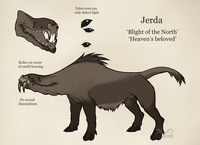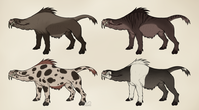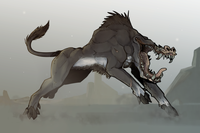Jerda
Spoonchomper
- Created
- 2 years, 7 months ago
- Creator
- Spoonchomper
- Favorites
- 5
Profile
Summary
The jerda(plural: jerda, jerdas) is a quadrupedal wild animal native to surface territories north of the Rift. The jerda is the largest and most aggressive member of the neck-mouth family. It is an apex predator with omnivorous tendencies during periods of scarcity. A group of jerda is called a horde.
Habitat
Jerda can be found in weather-habitable areas of Arabelean North(everything north of the Rift). Large presence of jerdas in a weather-habitable area makes it uninhabitable for ghalla. Jerda mostly inhabit dry habitats with small or no changes in altitude. Largest populations can be found in rocky plains that surround the Barren Gates mountain chain on both the Arabelean and Alvecharre side. No evidence has been found of jerda entering syllk tunnels or trying to cross rare land bridges into territories south of the Rift.
During heavenly winter storms that happen sporadically in weather-inhabitable areas jerda are known to dig shallow holes for themself and stay in those holes until the storm passes. Jerda avoid areas where the hottest temperature exceeds 25 degrees Celsius and no populations have been found in areas with the coldest temperatures reaching -60 degrees Celsuis.
Anatomy
The most well recognized features of the jerda are its neck-mouth, three toed hooves, reversely placed tusks, false eyes and large nose.
- Neck-mouth and teeth
The neck-mouth of a jerda is lined with powerful muscles that allow the heavy head of the jerda to be kept up. The neck-mouth is capable of both slow, deliberate movements, as well as quick "snappy" movements. It is lined with thick teeth ideal for crushing prey. The jerda can go through as many as 20 teeth sets in its lifetime. The reversely positioned tusks(bottom jaw fangs are behind the top jaw ones) are ideal for stabbing into prey and holding it down. - Three toed hooves
Each leg of a jerda ends in a three-toed cloven foot with two dew claws. The cloven feet are very durable and allow the jerda to easily dig through frozen ground in search of edible roots. Despite their formidable size the jerda is surprisingly fast and can develop speeds up to 55 km/h while charging at prey. - False eyes
Instead of fully functional eyes seen in most other mammalian species of Eraden the jerda posessess three false eyespots on its head(two pairs on the top half of the head and one pair on the bottom). The false eyes can only detect the presence of light and intense movement. The bottom pair of false eyes is usually damaged first during the jerda's life. - Nose and hearing
The jerda almost exclusively relies on the sense of smell and hearing to navigate its surroundings. The jerda possesses some of the strongest senses of smell among all recorded animals of Eraden. Jerda are said to keep a "scent grudge" for an entire lifetime, and will gladly hunt down the animal that wronged it if it comes across it again. Jerda's hearing is also exceptional, as they are capable of detecting muffled noises such as the rustling of leaves from 60 meters away. - Fur
The jerda pelt is well known for its rough texture and great insulation. Jerda shed biannually and leave mounts of the shed fur near rocks and trees that they use to scratch themselves. Jerda pelt is a sought out and rare resource that many have lost their lives trying to acquire.
Diet
Outside of periods of scarcity jerda prefer to hunt and scavenge, but will resort to digging out roots and plant matter if need be. No evidence has been found to suggest that jerda have a preference for a certain species of prey animals. Jerda often clash with Arabelean shepherds as jerda tend to invade ghalla-habitable areas to prey on herd animals such as ervasar and dermar.
In rare cases of extreme stress and famine jerda have been known to attack smaller jerda and even their own cubs.
Behavior
Jerda are often described as "furious". Many believe that their aggressive behavior is intentional and "on the level of ghalla"; jerda have been known to hold grudges against other animals and have been recorded having "temper tantrums" after a failed hunt or a lost battle. Jerda are easily agitated by flashing lights, strong and overwhelming scents, and loud jarring sounds. When agitated, they will lock down on the target and charge at it. The jerda will not stop its attack until the target has been completely destroyed. Many jerda even stay for a few hours in the area to ensure that their "opponent" stays dead.
Jerda cubs are much more mellow than adult individuals but still throw temper tantrums if disturbed. If an adult jerda noticed that a cub is in distress, a response similar toe agitated behavior follows.
Hunting Jerda
Surviving a Jerda hunt has been seen as the highest of honors since the beginning of recorded Arabelean history. Only those brave (and foolish) enough to try to approach a jerda even attempt such a feat, Usual hunting techniques include confusing a jerda with multi-source loud sounds or extreme scents, or tricking a jerda into running into a trap by agitating it or agitating a cub. Any man who manages to both survive a jerda hunt and bring back the tusks of a jerda acquired "a lifetime of bragging rights" and free food and drink when showing the tusks as a proof of validity.
Outside of the glory that the hunter gets if he survives, jerda hunting is very wasteful. Jerda meat is inedible to most other animals, including ghalla). meat has a pungent and vile smell that only gets sharper and more intense as it rots. Due to a large concentration of pheromones in the surrounding fat,meat has a pungent and vile smell that only gets sharper and more intense as it rots. Some Alvecharre tribes have developed methods for smoking and preserving jerda meat so that it's edible, but this product is only used during the times of extreme famine.
Lifecycle
The average jerda has a lifespan of 20 to 25 years. The longest lifespan is that of a jerda born and raised in captivity, which was recorder to be 55 years.
Jerda cubs are cared for by their mother until they reach 2 years of age, when the cubs are capable of feeding and defending themselves. From 2 years to 5 years of life the jerda is considered a sub adult, and reaches adulthood at 8 years old. While they are sexually mature as soon as they reach adulthood, jerda don't made until they are 12 years old. During this time the jerda acquires necessary skills to defend its territory and show its prowess to other individuals of its species. There is no sexual dimorphism between the sexes. In order to attract a mate, both male and female jerda let out a loud call that has been described as a mixture of deep-voiced screeching and bellowing. As a part of a mating ritual, the male and female jerda will have a ritualized fight. The male earns "a right" to mate with the female only if he manages to defeat her by toppling her down to the ground. Neither male or female are hurt during these fights. Fights between males are much more violent and often end in the death of the defeated jerda.
Jerda are solitary animals and will only congregate during the mating season, which takes place right after the winter period. Females usually give birth to one or two live young.


